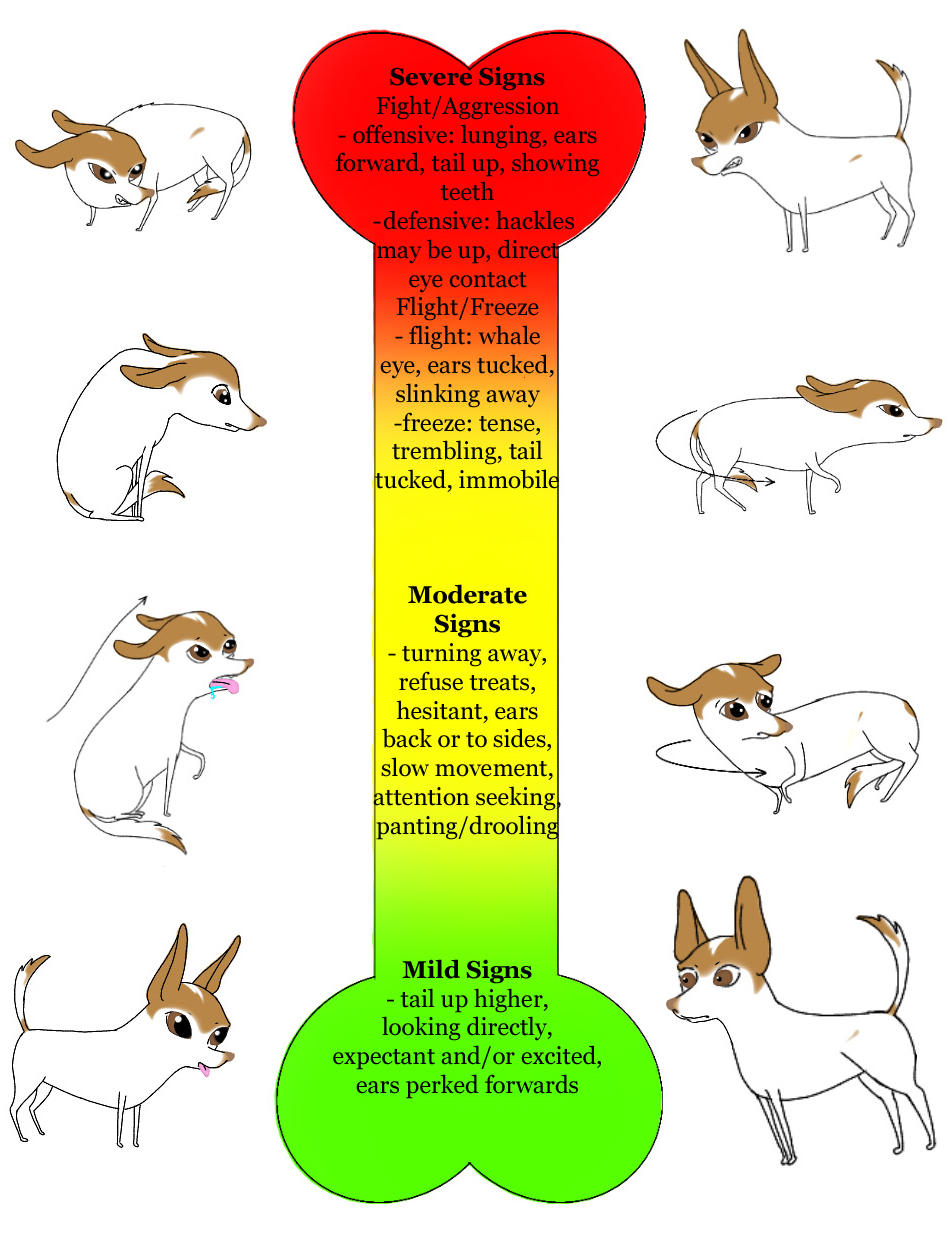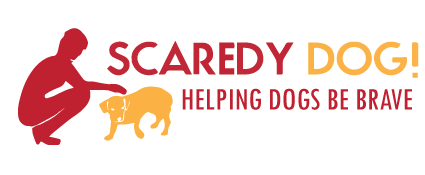Got Questions?
We have answers!

Despite how different each dog is, scaredy dogs have a lot in common and I’m often asked many of the same questions. They’re all scared of something and their pet owners want to find a way to bring peace into their lives. Below I’ve answered the most frequently asked questions. If you do not see your question addressed, please contact me or find Scaredy Dog on Facebook, and we will work together to get it answered.
What is a scaredy dog?
Scaredy dogs, much like scaredy cats, are dogs who having fear, anxiety, or shyness issues. Some dogs are just naturally high-strung or shy; if possible, ask if the dog’s parents have any behavioral issues before you adopt from a breeder. Sometimes this is due to trauma. If the dog has had a bad experience, he may learn to be afraid of anything that may lead to a similar experience. Sometimes this is due to injury or illness. If a pet is in pain, he will be much more wary of strangers petting him than his owner petting him. This can lead for his parents to think their dog is shy.
If your dog has severe anxiety or fear issues, take him to your vet first. I am a trainer, not a veterinarian. While I can make suggestions, I cannot diagnose medical problems or suggest medications for said problems. Only your vet can do that.
If your dog has severe anxiety or fear issues, take him to your vet first. I am a trainer, not a veterinarian. While I can make suggestions, I cannot diagnose medical problems or suggest medications for said problems. Only your vet can do that.
How can I help my scaredy dog?
Don’t ever force your dog to do something he doesn’t want to do. If your dog trusts you and you force him to take a bath while he panics and screams, you aren’t helping his fear or your relationship. Of course your dog needs to take a bath though – that’s why you need training to help him overcome his fear. I train to work through fear through a combination of desensitization (starting at a low level of stress and working our way up) and counter-conditioning (pairing scary things with lots and lots of good things). It’s important to take training as slow as your scaredy dog needs to – rushing to the next step will result in a step backwards in training. Let your dog set the pace!
There are other things you can try, such as giving your dog a high quality food. Studies have shown that a low-carbohydrate diet has a calming effect in dogs. Corn can actually reduce the amount of serotonin produced in the gut, and considering the gut contains up to 90% of the body’s serotonin, that can definitely cause behavioral problems.
You can find calming products in any pet store, including diffusers, sprays, collars, treats, etc. Experiment and see what works for you and your dog. You can also try diffusing chamomile and lavender oils, or putting a drop on your dog’s bedding. Again, if your dog’s fear-based behavioral problems are severe, don’t attempt training on your own – ask your vet and/or contact me for training.
There are other things you can try, such as giving your dog a high quality food. Studies have shown that a low-carbohydrate diet has a calming effect in dogs. Corn can actually reduce the amount of serotonin produced in the gut, and considering the gut contains up to 90% of the body’s serotonin, that can definitely cause behavioral problems.
You can find calming products in any pet store, including diffusers, sprays, collars, treats, etc. Experiment and see what works for you and your dog. You can also try diffusing chamomile and lavender oils, or putting a drop on your dog’s bedding. Again, if your dog’s fear-based behavioral problems are severe, don’t attempt training on your own – ask your vet and/or contact me for training.
How do I know if my dog is afraid?
There are subtle signs and not-so-subtle signs that your dog is getting nervous or stressed – it’s all in the body language. Early signs are hard to tell is certain breeds of dogs; for example, the tail is a major source of information about how your dog is feeling. If your dog’s tail is docked or you have a tail-less breed, it might be more difficult to tell. Likewise, the position of the ears is indicative of emotion but if you have a long-eared breed or your dog’s ears have been cropped, this limits the information available. Body language is huge, but even more importantly, you have to know your dog well. If you see signs that your dog is in the red zone, you have a serious problem – please ask you vet and/or contact me for help right away! See below for signs to look out for.
Wait… dogs can get OCD?
Obsessive compulsive disorder, or OCD, is classified as an anxiety disorder. While there is some debate on the phrase “obsessive compulsive disorder” when used on animals, anxious dogs can definitely exhibit OCD-like behavior such as licking and chewing, tail chasing, chasing lights, and snapping at invisible flies. Some breeds are more prone to this than others. For example, German Shepherds are prone to obsessive tail chasing; Dobermans are prone to flank sucking; Labradors are prone to pica (eating inanimate objects); spaniels are prone to light chasing and fly snapping. Again, a lot of this is hereditary so if possible, ask about behaviors seen in the parents and past litters before you adopt from a breeder.
What is puppy socialization and why is it important?
I frequently hear parents say “I think my dog was abused in his past home because…” but this is actually often not the case. Dogs inherently don’t like being pet on top of the head; just because they flinch away from a hand above them doesn’t mean they were abused. If your dog barks at the vacuum cleaner, it doesn’t necessarily mean he had a traumatic incident with it – he just doesn’t know what it is. There is a critical socialization period between the ages of 3 weeks to about 4 months. A dog may be afraid of anything he sees later in life that he hadn’t encountered during this period, including other people and other dogs. This is why it’s important to introduce your puppy to anything and everything you can think of. Paired with lots of good food to teach positive associations, and your dog is set up for success.
How am I supposed to introduce my puppy to other dogs? He hasn’t had his shots yet!
There are two trains of thought on this subject. The American Veterinary Medical Association (AVMA) recommends waiting until your dog has had all of his vaccines and boosters before meeting other dogs. However, puppies don’t receive their last boosters until about 6 months of age, well after the critical socialization period has ended. This can cause behavioral problems later in life. The American Animal Hospital Association (AAHA) recommends socializing your dog CAREFULLY during the socialization period, even though the puppy hasn’t had all of his shots. The reasoning behind this is that many more dogs are put down every year due to preventable behavioral problems than puppies die of puppyhood diseases. Studies have shown that puppies that were put in a puppy play camp or puppy socialization class had far fewer behavioral problems. The risk of getting a serious puppyhood disease was only slightly increased from dogs who were quarantined until 6 months of ago. Read my guide on puppy socialization for more information.
How does your training program work?
There are two options for training packages, coaching and day training. Coaching is when I come to work with you and your dog once a week and assign you exercises to work on. Day training is when I come to your house to train your dog myself; you do very little of the work. You don’t even need to be present – go to work and let me train your dog for you! Depending on your specific dog and issues, I may assign some homework, but I will do the majority of the work.
I sell training packages of 3 per week, or 12 per month (3 per week for 4 weeks). While I prefer to train per week or per month (and it’s cheaper for you), I also train as needed on an hourly basis.
I sell training packages of 3 per week, or 12 per month (3 per week for 4 weeks). While I prefer to train per week or per month (and it’s cheaper for you), I also train as needed on an hourly basis.
How many sessions will this take?
There’s no straightforward answer to that question; it depends on your dog, your dog’s problem, and the severity of the problem. Some dogs will never be outgoing despite training. However, if the problem is caught early, some problems such as anxiety and OCD can be remedied in as little as a month.
What is sit and train?
If you need a pet sitter and you’d like me to work on something while you’re away, we can combine the training and pet sitting charges to give you an amazing deal! Go on vacation and come home to a better-behaved dog!





